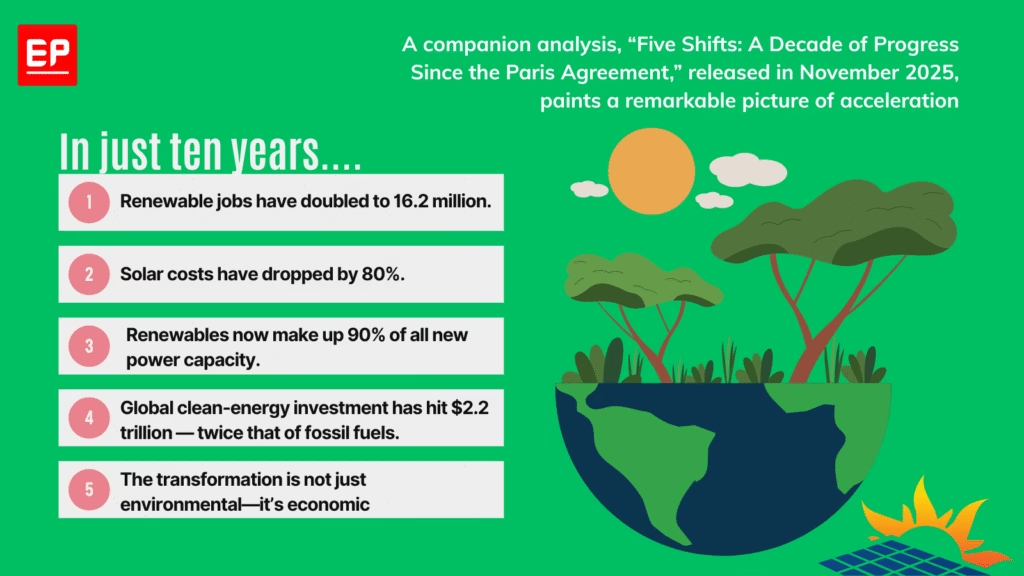COP30
Brazil Cuts Emissions by 17% in 2024—Biggest Drop in 16 Years, Yet Paris Target Out of Reach
Brazil’s 2024 emissions dropped 16.7% to 2.15 GtCO₂e, led by Amazon deforestation control—the biggest annual fall since 2009—but the country still risks missing its Paris climate goals.

Brazil’s groEmissionsss greenhouse gas emissions fell from 2.576 billion tons of CO₂ equivalent in 2023 to 2.145 billion tons in 2024, the lowest drop since the country’s 17.2% decline in 2009. This turnaround was powered by enforcement against illegal deforestation, reversing a period of lax protections between 2019 and 2022. The net emissions figure—which deducts carbon absorbed by secondary forests and protected areas—dropped even further, down 22% year-on-year, landing at 1.489 billion tons in 2024.
Sectoral Breakdown: Where Emissions Fell and Rose
The land-use sector, mostly deforestation, saw its gross emissions tumble from 1.341 to 0.906 billion tons (32.5% drop)—the largest reduction on record for any sector. This shifted the national emissions profile:
>> Land use change: 42% in 2024, compared to 52% in 2023
>> Agriculture: 29%, up from 24%
>> Energy: 20%, up from 16%
>> Waste: 5%
>> Industrial processes: 4% (both stable)
Emissions in agriculture and energy remained mostly flat, with only waste (up 3.6%) and industry (up 2.8%) recording notable increases.
Deforestation Down, but Not the Whole Story
Enhanced government actions led to a 33% decline in Amazon deforestation emissions and a 41% drop in the Cerrado. Nevertheless, fires not associated with deforestation nearly doubled Brazil’s net deforestation emissions—an emerging risk as climate change fuels extreme drought and wildfires across formerly resilient biomes.
Agriculture, Cattle, and Energy: Stubborn Sources
Brazil’s cattle sector remains the single largest emissions source, responsible for roughly 51% of national total. Efforts to control methane—including increased feedlot use and smaller herds—delivered a marginal 0.2% reduction in herd size and a slight drop in emissions. Nitrous oxide from fertilizers and lime also saw small declines, offsetting overall emission growth. Notably, emissions from energy rose nearly 1% due to record travel and electricity demand; only record ethanol and biodiesel consumption kept fossil CO₂ in check.
Paris Pledge Still Out of Sight
Despite the historic emissions drop, Brazil is projected to end 2025 with net emissions of 1.44 billion tons—9% above its target under the Paris Agreement of 1.32 billion tons. While deforestation is falling, rising emissions from energy, agriculture, waste, and industry threaten to undermine overall climate progress. Experts emphasize that broader emission cuts, especially in fossil energy, are urgently needed for Brazil to have a chance at meeting its 2030 target (1.2 billion tons).
Brazil’s 2024 emissions breakthrough underscores the pivotal impact of deforestation control on the country’s climate footprint. Yet, absent deeper reforms in agriculture, waste, and especially energy, Brazil’s Paris goals may remain out of reach—a clear signal for policymakers ahead of COP30.
COP30
India Among World’s 10 Most Affected Nations from Extreme Weather
India ranks ninth in the Climate Risk Index 2026, with over 80,000 deaths and $170 billion in damages from floods, cyclones and heat waves in the past 30 years.

India has been ranked ninth globally among countries most affected by extreme weather events over the last 30 years, according to the Climate Risk Index (CRI) 2026 released by Germanwatch at COP30 in Belém.
The index found that between 1995 and 2024, India experienced nearly 430 major extreme weather events, leading to more than 80,000 deaths, affecting 1.3 billion people, and causing economic losses worth USD 170 billion (inflation-adjusted).
India’s frequent floods, cyclones, and heat waves have made recovery increasingly difficult. “Entire regions can hardly recover before the next disaster hits,” said co-author Vera Künzel in a statement.
Extreme heat events have also become more frequent, with temperatures soaring to 50°C in several states. Catastrophic floods in Uttarakhand (2013) and cyclones such as Amphan (2020) and Hudhud (2014) were among the most damaging disasters.
Germanwatch notes that countries in the Global South, including India, bear the heaviest burden despite contributing least to global emissions.
COP30
Over 832,000 Lives Lost, $4.5 Trillion in Damages, Extreme Weather The “New Normal”: Warns Climate Risk Index
A new report reveals the staggering toll of extreme weather — over 832,000 deaths and $4.5 trillion in losses between 1995 and 2024.

The numbers are stark, and the story they tell is even starker. More than 832,000 people have lost their lives and USD 4.5 trillion in direct economic losses have been recorded worldwide as a result of nearly 9,700 extreme weather events over the past three decades. That is the central finding of the Climate Risk Index (CRI) 2026, released by the environmental think tank Germanwatch at COP30 in Belém, Brazil.
The new report — the most comprehensive edition of the CRI to date — presents what its authors describe as a “mirror to global injustice”: a world where the poorest nations, least responsible for greenhouse gas emissions, continue to suffer the greatest losses.
Global South at the epicentre
According to the analysis, around 40% of the world’s population — more than three billion people — live in the eleven countries most affected by extreme weather events since 1995. These include India (ranked 9th), China (11th), Haiti (5th), and the Philippines (7th) — all nations of the Global South. None of these countries belong to the world’s richest economies, yet they bear the heaviest brunt of climate shocks.
“Heat waves and storms pose the greatest threat to human life when it comes to extreme weather events,” said Laura Schäfer, one of the index’s lead authors, in a statement. “Storms also caused by far the greatest monetary damage, while floods were responsible for the greatest number of people affected.”
In the 30-year period covered, storms alone caused over USD 2.64 trillion in damages, while floods accounted for nearly half of all people affected by disasters. Floods, storms, heat waves, and droughts together formed the deadly quartet responsible for most of the losses — both human and economic.
A decade of unrelenting disasters
From hurricanes that erased Caribbean islands to floods that swept away entire cities, the CRI 2026 paints a grim global mosaic.
At the top of the long-term index is Dominica, a tiny Caribbean island nation that has faced multiple catastrophic hurricanes. In 2017, Hurricane Maria alone caused losses amounting to three times the country’s GDP.
Myanmar ranks second, largely due to Cyclone Nargis (2008), which killed nearly 140,000 people and left deep scars still visible today. Honduras, Libya, Haiti, and Grenada follow, all of which endured either singularly devastating or repeated disasters.
The report notes that countries like Haiti, the Philippines, and India are trapped in cycles of destruction and recovery. “They are hit by floods, heat waves, or storms so regularly that entire regions can hardly recover from one disaster before the next strikes,” explained Vera Künzel, co-author of the index.
India among the top ten
India’s inclusion in the top ten highlights the scale and variety of climate hazards the country faces. Between 1995 and 2024, India endured over 430 major extreme weather events, resulting in more than 80,000 deaths, affecting 1.3 billion people, and inflicting USD 170 billion in damages (inflation-adjusted).
Recurring heat waves, increasingly intense monsoons, and devastating cyclones — from Odisha (1999) to Amphan (2020) — have made India one of the world’s most climate-vulnerable economies. Urban flooding in states like Maharashtra and Gujarat, and glacier-related floods in the Himalayas, have further underscored this fragility.
Even the rich are not spared
While the Global South remains most exposed, the new index shows that climate risks are no longer confined by wealth or borders. The United States (ranked 18th) and European nations such as France (12th) and Italy (16th) appear among the top 30 most affected countries — a reminder that the climate crisis has become universal.
“COP30 must find effective ways to close the global ambition gap”
The authors warn that no country is immune from the accelerating impacts of global warming. The year 2024 was the hottest on record, with global temperatures surpassing 1.5°C above pre-industrial levels for the first time. Scientists estimate that human-caused climate change added 41 extra days of dangerous heat for billions of people last year alone.
“The CRI 2026 results clearly demonstrate that COP30 must find effective ways to close the global ambition gap,” said David Eckstein, another co-author. “Global emissions have to be reduced immediately; otherwise, there is a risk of a rising number of deaths and economic disaster worldwide.”
A call for climate justice
The report urges the world’s wealthier nations to deliver on their long-standing promises of climate finance and loss-and-damage support for developing countries. Despite repeated commitments, funding for adaptation and disaster recovery remains far short of what vulnerable nations need.
Germanwatch estimates that developing countries may require up to USD 1.7 trillion annually by 2050 to address loss and damage caused by climate impacts. Without this support, the gap between rich and poor in climate resilience will only widen.
The CRI 2026 also points to positive developments — notably, a recent International Court of Justice advisory opinion affirming states’ legal duty to prevent and address climate harm, including through finance and reparations. The ruling, the authors note, adds legal and moral weight to the demands for urgent global action.
A warning — and a choice
Ultimately, the report is more than a statistical document; it is a warning. The patterns of destruction it reveals — from hurricanes in the Caribbean to heat waves in Asia — are not anomalies but signs of a “new normal.”
As COP30 negotiators gather in Belém, the message from the data is clear: unless emissions fall sharply and adaptation accelerates, the toll in both human lives and economic costs will keep rising.
“In a warmer world, tropical cyclones are becoming more intense and more destructive,” said Lina Adil, co-author of the index. “Without sustained global support, some nations will face challenges that are simply insurmountable.”
COP30
COP30: How People, Not Politics, Are Powering the Next Phase of Climate Action
From rooftop revolutions to billion-dollar clean-energy investments, the global shift toward renewables is already happening — citizens and markets are leading where politics still hesitates.

As the world converges on Belém for the 30th UN Climate Change Conference (COP30), the air is heavy not just with Amazonian humidity—but with expectation. Ten years after the Paris Agreement, the story of global climate action has entered a new chapter. One defined less by negotiation rooms and more by rooftops, communities, and citizens who have already begun to build the future politicians still debate.
A new statement released just a week before the summit, titled “Protect What We Love,” captures this shift. Signed by 75 leaders across politics, culture, and civil society—including Christiana Figueres, Ban Ki-Moon, Mary Robinson, Richard Branson, Stella McCartney, and Dia Mirza—the call to action urges governments to finally transform past commitments into tangible plans.
“You agreed to transition away from fossil fuels. You agreed to halt and reverse deforestation. You agreed to mobilize finance for adaptation and mitigation in developing countries,” the statement reminds world leaders. “At COP30, we ask you to show us how—through concrete plans and timelines—so that we can protect the people and places we love.”
This appeal comes amid fresh global polling data showing what the authors call “the 89%”—an overwhelming majority of citizens worldwide who want faster climate action. The findings, by the Potential Energy Coalition, reveal that eight in ten people across ten countries support government investment in wind, solar, and nuclear energy—double the number backing fossil fuels. And notably, that support transcends politics. Even conservatives, often framed as skeptics, are 1.6 times more likely to favour clean-energy investment than fossil fuel subsidies.
A Decade That Defied Predictions
That popular consensus coincides with new evidence of real progress. According to “Five Shifts: A Decade of Progress Since the Paris Agreement,” released in early November 2025, the world has made more headway in clean-energy deployment and policy integration than most experts dared to expect back in 2015.
In the decade since Paris, renewable energy jobs have nearly doubled to 16.2 million, and annual clean-energy investments reached $2.2 trillion—twice that of fossil fuels. Ninety percent of all new power capacity added globally in 2025 came from renewables. Solar costs have plummeted by 80% since 2014.
The transformation is not just environmental—it’s economic. “The fossil fuel industry knows that the new economy is rising,” said Christiana Figueres, one of the architects of the Paris Agreement. “They know that they can no longer compete. We are no longer in a world in which only climate politics has a leading role, but increasingly climate economics.”

That’s a profound shift in the centre of gravity. In 2015, climate action depended on international consensus. In 2025, it increasingly depends on investment logic.
From Pledges to Proof
Still, COP30 will test whether politics can keep pace with the real world. “It’s a different kind of COP than we’ve had before,” said Jennifer Morgan, Germany’s Special Envoy for International Climate Action. “It is one where there’s not one big fund or one big outcome. One really needs to be looking at the signals, the decisions, and the proof points to see how leaders and countries are accelerating implementation—because that’s what this is all about: going faster, going further, building on the success, learning the lessons of the lack of success.”
The Five Shifts report echoes that sentiment. Its authors warn that while clean energy is winning both economically and politically, emissions are not yet falling at the speed required. The UNEP Emissions Gap Report 2025, published days before the summit, estimates that even with full implementation of current national climate plans (NDCs), global warming would reach 2.3–2.5°C, and 2.8°C under existing policies.
$2.2 trillion in clean-energy investment in 2025 — twice fossil fuels
The world is already 1.35°C warmer, with extreme heat events multiplying by a factor of nine since 2015. Yet the same report highlights practical successes: half of all countries now have heat-warning systems, and 47 operate national heat action plans, saving lives in cities from Senegal to Japan.
For Bill Hare, CEO of Climate Analytics, the takeaway is simple: “The world can still return to well below 1.5°C if the highest possible ambition is pursued by countries starting now. Getting to net zero carbon dioxide emissions means that we can halt warming pretty quickly.”
Citizens Are the New Climate Majority
What distinguishes COP30 from the summits before it is not just scientific urgency—it’s civic clarity. As the Protect What We Love statement declares, “We are the 89%: the overwhelming majority of the global population who want you to act faster on climate change.”
That human dimension is front and centre. Leanne Brummell, representing Parents for Future Global, spoke for millions of families when she said:
“As parents, our first duty is to protect our children. The climate crisis is a direct threat to their safety and their future… We are part of the 89% of people globally who want to see their governments take more action to protect the places and people we love.”
The emotional urgency resonates far beyond activist circles. Dia Mirza, actor and UN advocate, said: “As a mother, I see the truth of today’s statement in my children’s eyes every day. People everywhere are rising to build, buy, and create the solutions that will keep our children safe. Public support for climate action is undeniable, and the technology and answers already exist. At COP30, I ask world leaders to act with the same instinct every parent has—to protect what we love most: our children and their future.”
This groundswell of public will is now being matched by business leadership. A new E3G poll found 97% of global executives backing a rapid transition to renewable-based electricity. Major corporations have joined the We Mean Business coalition, urging governments to create policies that reward decarbonization rather than delay it.
“Climate breakdown is no longer a distant risk for business—it’s already disrupting operations through extreme weather events such as floods and droughts,” said Fiona Duggan, Global Sustainability Manager at Unilever. “Forward-thinking companies are moving to adapt and decarbonise as rapidly as their sectors will allow. The real question is whether governments will support them to go further, faster.”
Constructive Pathways: What’s Working
A decade of experimentation has produced more success stories than cynics expected. Countries once seen as dependent on fossil fuels—Nigeria, Senegal, Brazil, Indonesia—are embedding climate action into fiscal and planning systems. Nigeria’s 2021 Climate Law supports a 2060 net-zero target; Senegal’s local experts now drive national adaptation plans; Brazil’s Finance Ministry leads an Ecological Transformation Plan linking fiscal reform with green growth.
According to Henri Waisman, Director of the DDP Initiative, “Countries have begun to reshape climate governance, embed long-term perspectives into policymaking, and accelerate technological change. This progress is significant. But the lesson of the past decade is equally clear: if we are to achieve the goals of Paris, the next decade must be about scaling up efforts, addressing social and industrial challenges, and ensuring that ambition is consistently translated into effective action.”
These local models, backed by citizens’ trust and economic dividends, suggest that climate action isn’t just a moral imperative—it’s a viable development strategy.
The Belém Moment
If there’s a unifying message emerging from Rio’s press releases to Belém’s plenary halls, it’s this: the transition has already begun.
Citizens, investors, and innovators are not waiting for permission. “Ordinary people understand that clean energy will improve their lives and have begun the transition their leaders keep promising,” said environmentalist Bill McKibben. “Rooftop by rooftop, community by community, they’re proving the future can arrive before the politics to govern it.”
COP30 thus becomes less about what to agree upon—and more about how fast to deliver what’s already agreed. The Five Shifts report puts it succinctly: “COP30 must move beyond pledges to concrete delivery: addressing the ambition gap in current NDCs, accelerating finance for adaptation, and ensuring just transitions away from fossil fuels. The decisions made in Belém will determine whether the 2030s become a decade of decisive implementation.”
From Political Will to Public Proof
Ten years ago, in Paris, climate ambition was an act of collective imagination. In Belém, it’s a lived reality, visible in data, rooftops, and balance sheets. The clean-energy revolution is no longer hypothetical—it’s happening.
The challenge now is whether governments will catch up with their citizens. Because, as the 89% have made clear, the mandate to act isn’t waiting for another conference. It’s already out there—building, investing, and protecting what we love.
-

 Space & Physics6 months ago
Space & Physics6 months agoIs Time Travel Possible? Exploring the Science Behind the Concept
-

 Know The Scientist6 months ago
Know The Scientist6 months agoNarlikar – the rare Indian scientist who penned short stories
-

 Know The Scientist5 months ago
Know The Scientist5 months agoRemembering S.N. Bose, the underrated maestro in quantum physics
-

 Space & Physics3 months ago
Space & Physics3 months agoJoint NASA-ISRO radar satellite is the most powerful built to date
-

 Society5 months ago
Society5 months agoAxiom-4 will see an Indian astronaut depart for outer space after 41 years
-

 Society5 months ago
Society5 months agoShukla is now India’s first astronaut in decades to visit outer space
-

 Society5 months ago
Society5 months agoWhy the Arts Matter As Much As Science or Math
-

 Earth5 months ago
Earth5 months agoWorld Environment Day 2025: “Beating plastic pollution”



















